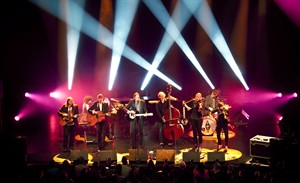Elevate your local knowledge
Sign up for the iNFOnews newsletter today!
Sign up for the iNFOnews newsletter today!
Selecting your primary region ensures you get the stories that matter to you first.

TORONTO – As four kids from suburban Ontario barely old enough to drink, Sum 41’s first “Saturday Night Live” experience would have felt surreal enough under normal circumstances.
But mere weeks after 9/11, these were not normal circumstances.
“The entire planet was in shock,” reminisced the band’s former drummer Stevo Jocz in a telephone interview.
“The city seemed different and weird. You could still smell the buildings on fire — there was this sulphur smell, this weird burning smell that just sort of consumed the entire city.
“It was weird. And also it was weird because everyone was so nice.”
For the select group of Canadian artists who have ascended to the “Saturday Night Live” stage over its 40 years — and the show’s starry anniversary special airs Sunday — it’s a simultaneously jittery and exhilarating experience.
That was perhaps especially true for Jocz and his bandmates.
It was the second episode back for “Saturday Night Live” after the terrorist attacks. A week before, more than 17 million viewers tuned in as Lorne Michaels asked then-New York mayor Rudy Giuliani whether the show could still be funny (his response: “Why start now?”).
The atmosphere remained emotionally charged. Ben Stiller had originally been scheduled to host but pulled out and was replaced by Seann William Scott.
Giuliani was backstage again for the second episode, as was Chevy Chase (Jocz remembers that the “Vacation” star barged into Sum 41’s packed dressing room to say hello, cutting through the crowd by shouting “Hot soup!”)
Jocz was only 20 at the time, and the Ajax punk-brats were months from releasing their breakthrough debut “All Killer No Filler.”
Although performing “Fat Lip” and “In Too Deep” brought nerves, it was a different stage interaction that provoked real anxiety: the customary end-of-show farewell group hug.
“That was more nerve-racking than the actual performance — ‘Oh my God, I have to hug all these weird people I don’t know?’” he remembered. “I’m physically kind of awkward. I would rather not hug anybody.
“I said if I’m going to hug anybody, I want to hug Will Ferrell. … So they say goodnight, thanks for a good week, and I hug Cone (bassist Jason McCaslin) just to get the ball rolling, and it’s my chance to turn around and hug Will Ferrell.
“I turn around, I open my arms — and he shut me down with a handshake,” he adds. “He kind of gave me a very serious, polite but formal nod, like ‘Nice to meet you.’ Like a dad or something like that.
“I just wanted a hug, Will!”
When Toronto’s Cowboy Junkies performed on the show in 1989, guitarist Michael Timmins recalls a slightly warmer welcome from the crew — especially Regina-born host Leslie Nielsen and a young Mike Myers, who happened to debut “Wayne’s World” in that episode.
“We still, to this day, hear people say that’s when they first saw us, on ‘Saturday Night Live,’” said Timmins.
And few Canadian acts have been granted as much “SNL” airtime as Arcade Fire.
The artful Montreal rockers have served as musical guest three times — tied with Avril Lavigne and lagging behind only Neil Young — and on a fourth occasion showed up to back Mick Jagger in 2012.
During the 2013 season premiere, they even appeared in a sketch: a mock game show during which host Tina Fey had to differentiate between members of Arcade Fire and the show’s fresh-faced new cast hires.
Brothers Will and Win Butler withstood a minor roasting from Fey — she said singer Win resembled a “hipster Paul Bunyan,” a “Civil War re-enactor” and a “Serbian basketball player.”
And they loved it.
“(‘SNL’) has been shockingly lovely to us from Day One,” said Will Butler in a telephone interview. “(Creator) Lorne (Michaels) really relates to us for some reason.
“He knows when something is real and something is good and he’s like: ‘These guys are real.’”
Sum 41, for what it’s worth, also had a repeat opportunity on the “SNL” stage in 2005, backing Ludacris on a rowdy rap-rock version of “Get Back.”
Jocz recalls being briefly tripped up by the song’s odd time signature, and Ludacris “kind of turned around and looked at me and knew right away that I (messed) up.”
It wasn’t as memorable as their first time.
And charging into a wounded New York during a period when many were wary of travelling there somehow set a standard for the band, who would later tour Japan two months after the Fukushima nuclear disaster and risk their lives in a war-scarred part of Africa.
“We make a lot of really weird choices,” conceded Jocz. “But there was no second-guessing (‘SNL’). We just wanted to do it.”
— Follow @CP_Patch on Twitter.
This site is protected by reCAPTCHA and the Google Privacy Policy and Terms of Service apply.
Want to share your thoughts, add context, or connect with others in your community?
You must be logged in to post a comment.